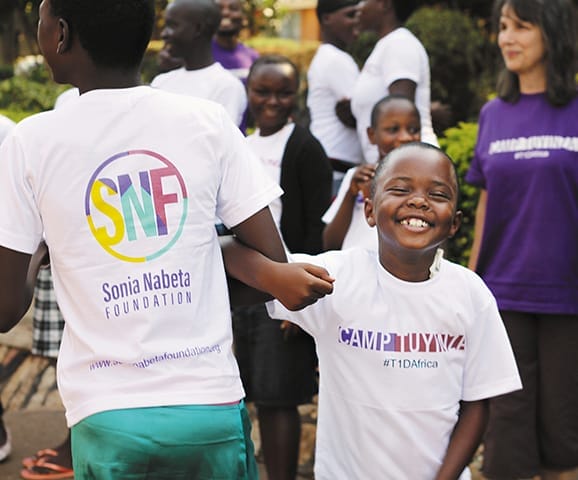As the baby of a large Ugandan family, my sister Sonia was the apple of everyone’s eye. She was affectionately called Sunny Sunshine; her ever-present smile and enormous heart made her a favorite sibling and best friend to each of us, and my four-year-old nephew’s dream of the perfect mom. Witty and with a wicked sense of humor, she could waft away somber moments with gales of laughter. She entertained us with her humor as much as she educated us on the history of popular culture and music, such as why Nick Jonas’s song “Levels” has its roots in the Baroque era. Then, on August 5, 2015, Sonia died. God is ineffable, and one cannot begin to understand why He decides the way He does, but there it was—at age 24, our Sunny Sunshine was gone. A sudden hypoglycemic attack had barreled through her defenses, and Type 1 diabetes—T1D, also known as juvenile diabetes—had won.
Sixteen years earlier, when my sister was diagnosed with T1D, it seemed as though she was the only child in Uganda with the condition. Our parents looked in vain for support groups or medical personnel who understood the condition. Schools had no idea how to handle Sonia, and the requisite support and awareness didn’t exist. We felt alone, and even more critically, my sister felt alone. Our parents diverted all their modest resources to supporting her—she had a doctor, a nurse, a psychologist, a dietician, a personal trainer, and a fully equipped clinic only a few yards from our home. Always conscious of the huge sacrifice our parents had to make for her, Sonia wondered how the not-so-lucky children in Uganda could possibly cope.
The fortunate kids who do see health professionals often find that T1D isn’t on the health index of the diagnosing physician. The story of 12-year-old Manuela Nyende Wakabi, for example, begins with several weeks of erroneous diagnoses from numerous hospitals and healers. By the time her T1D was diagnosed, her body had gone into a state of severe stiffness that didn’t subside for months. Other common stories tell of children shunned by schools and communities, ousted from homes, and even considered by some to be possessed by demons. While some children with T1D do make it into adulthood, many are burdened with complications because of poorly managed blood sugar levels. In Uganda, T1D is a financially backbreaking disease, requiring at least $700 a year for basic tests and supplies. In a country with an average per capita income of around $600, one where 19.5 percent of the population lives below the poverty line, this cost is prohibitive. The struggles of those with T1D in Africa are vastly different from the challenges in developed countries such as the United States. Africa’s T1D mortality rate remains high for several reasons, including lack of awareness, insulin insecurity and the hefty cost of treatment. In Uganda, for instance, there are only four pediatric endocrinologists in a country of 39 million people, roughly 60 percent of whom are under 18 years of age. Many children remain undiagnosed, and some die without ever seeing a medical professional.
Sonia journaled her dream of one day changing this state of affairs for children with T1D in Africa. So the day Sonia joined the angels, it became incumbent on us, her family, to carry out her wish through the Sonia Nabeta Foundation. Because the scourge of infectious diseases makes it difficult for African nations to prioritize T1D, the Sonia Nabeta Foundation will work with governments and other partners to alleviate the hefty cost of treatment and provide holistic mind, body and spirit health care for low-income children in Africa with T1D—or, as we affectionately call them, T1D Warriors.
In this inaugural year, our focus has primarily been on advocacy, raising awareness and shining a spotlight on this issue, starting in Uganda. To mark the one-year anniversary of our honoree’s welcome into the next life, the foundation hosted a four-day camp for T1D Warriors, as well as health care worker training. Camp Tuyinza (which translates to Camp “We Can Do This”) was opened by the queen of Buganda, Nnabagereka Sylvia Nagginda, and brought together 54 children from Uganda and Ghana for education, play and activities. (The talent show and a zoo trip were big hits.) The health care worker training, led by a volunteer team of doctors and medical experts from the University of Minnesota, educated 20 health workers and gave them an opportunity to use their newfound skills with the Camp Tuyinza kids.
As our nascent organization slowly begins to gain its footing, year two will continue advocacy and awareness, as we work with the Ugandan Ministries of Health and Education and other partners and stakeholders to communicate the scope and depth of this issue. In time, together, we will find solutions to improve diagnosis and deliver affordable resources to the under-served and overwhelmed families struggling with T1D.
While securing sustainable financing for little-known nonprofits is incredibly difficult, we’re hopeful that the need will speak for itself and our mission will resonate with a wider community. African children with T1D should and can have hope. So until my sister does her impeccable Sheldon Cooper impersonation and pipes out a Bazinga! from on high, we’ll carry on, in memoriam, through the Sonia Nabeta Foundation.
Vivian Nabeta is president of the board of directors of the New York-based Sonia Nabeta Foundation.
SONIA NABETA FOUNDATION
The foundation takes a four-pronged approach to combating Type 1 diabetes in Africa:
1. Providing essential tests and supplies
2. Hosting wellness camps
3. Sponsoring awareness campaigns and health care worker training
4. Advocating for T1D protocols at all general hospitals
Published as “A Sister’s Crusade” in the Fall 2016 issue of Wharton Magazine.

























